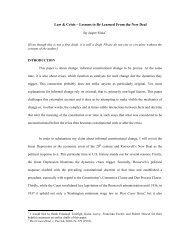updating brignoni-ponce - New York University School of Law
updating brignoni-ponce - New York University School of Law
updating brignoni-ponce - New York University School of Law
Create successful ePaper yourself
Turn your PDF publications into a flip-book with our unique Google optimized e-Paper software.
570 LEGISLATION AND PUBLIC POLICY [Vol. 11:567<br />
cluding background information on how U.S. immigration policy and<br />
enforcement subordinates noncitizens, a description <strong>of</strong> the neverpassed<br />
End Racial Pr<strong>of</strong>iling Act, and an analysis <strong>of</strong> courts’ recent attempts<br />
to modify Brignoni-Ponce. Part III assesses the applicability<br />
<strong>of</strong> the Court’s reasoning in Brignoni-Ponce to the modern environment,<br />
taking into consideration current demographic trends, a nuanced<br />
understanding <strong>of</strong> immigration, and the harm resulting from the permissible<br />
use <strong>of</strong> race. Part IV considers the practical impact <strong>of</strong> disallowing<br />
the consideration <strong>of</strong> race and concludes that permitting the<br />
consideration <strong>of</strong> race as a factor in deciding whether to make a stop is<br />
better than encouraging immigration law enforcement to mask their<br />
reliance on racial appearance.<br />
I.<br />
CURRENT LAW ON THE PERMISSIBLE USE OF RACE IN<br />
IMMIGRATION ENFORCEMENT<br />
Investigatory stops allow law enforcement <strong>of</strong>ficers to stop a pedestrian<br />
or motorist and ask that person questions to determine<br />
whether or not criminal activity is about to occur. 8 These stops cannot<br />
be conducted arbitrarily, thanks to the Fourth Amendment. However,<br />
the Court has construed the constitutional right to be free from governmental<br />
search and seizure as requiring only a reasonable suspicion to<br />
justify an investigatory stop. 9 As such, a Border Patrol <strong>of</strong>ficer can<br />
stop a vehicle if the <strong>of</strong>ficer has reasonable suspicion to believe that at<br />
least one <strong>of</strong> the occupants is an undocumented immigrant. 10 In<br />
Brignoni-Ponce, the Supreme Court held that the <strong>of</strong>ficer can consider<br />
the occupant’s apparent ancestry in making this assessment. 11 In order<br />
to understand how this came to be the rule, this Part presents cases<br />
leading to Brignoni-Ponce and analyzes the decision itself.<br />
A. Search and Seizure Standard for Police Stops<br />
The Fourth Amendment provides that people have a right “to be<br />
secure in their persons, houses, papers, and effects, against unreasonable<br />
searches and seizures.” 12 This right is not to be violated except<br />
upon probable cause; 13 however, the Court has held that certain<br />
searches and seizures are reasonable and therefore need only be justi-<br />
8. See Terry v. Ohio, 392 U.S. 1, 9–10, 30–31 (1968).<br />
9. Id.<br />
10. United States v. Brignoni-Ponce, 422 U.S. 873, 884 (1975).<br />
11. Id. at 885–86.<br />
12. U.S. CONST. amend. IV.<br />
13. Id.
















